
views
Loosening Shoes with a Shoe Stretcher
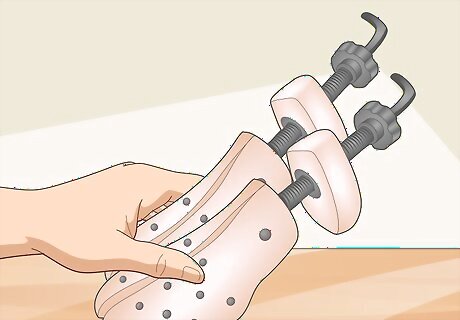
Buy a quality two-way shoe stretcher online or at a specialty footwear retailer. You can snag one of these nifty devices for around $20-30, though prices can vary depending on the materials used, as well as the complexity and sturdiness of construction. For this sort of fix, you’ll need a model that offers a two-way stretch. These are designed to expand lengthwise, whereas simple one-way stretch models only expand widthwise. Most shoe stretchers are made of wood, but you’ll also find some made of plastic, metal, or some combination of these materials. Shoe stretchers tend to work best with shoes made from naturally supple materials like leather, but you may have some success with textile and synthetic kicks, as well.Tip: A shoe stretcher can be a worthy investment if you have more than one pair of shoes that you’ve outgrown slightly but still want to be able to wear.
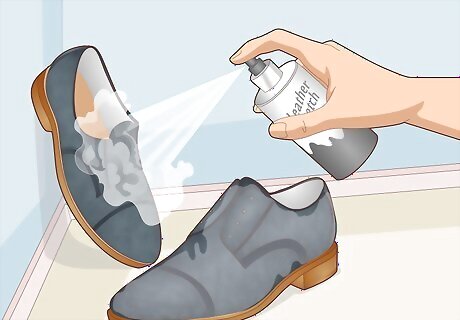
Pre-treat genuine leather and suede footwear with shoe stretch spray. Mist the entire upper surface of your shoes evenly and allow the spray to soak in for about a minute. Focus on areas where the shoes are especially tight, such as the toe box, midfoot, and rear wall. As it’s absorbed, the spray will encourage the stiff leather to relax. For best results, the manufacturers of some stretch sprays recommended applying their products to the inside of the shoe, as well. Shoe stretch sprays are a type of specially-formulated leather conditioner, and shouldn’t be used on shoes made from canvas, synthetics, or other materials. Not only will it not be effective, it could end up staining or otherwise ruining the fabric.
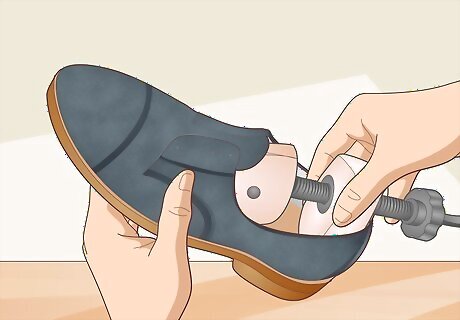
Insert the stretcher into one of your shoes as far as it will go. When properly placed, the forefoot piece should be nestled securely against the inside of the toe box, with the free-moving heel piece situated inside the heel portion of the shoe. Make sure that the wide end of the heel piece is resting against the insole. If it’s your first time using your new stretcher, you may need to collapse it a bit to get it to fit inside the shoe. You can accomplish this by rotating the small knob on the heel end counterclockwise.
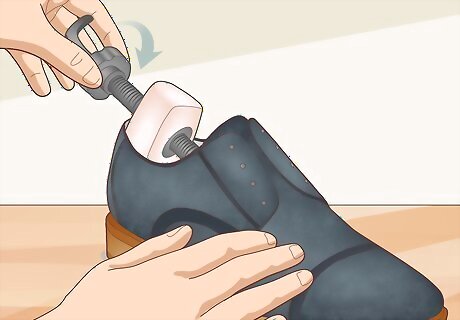
Turn the knob near the back of the device clockwise to expand it lengthwise. This action will cause the heel piece to slowly move farther and farther away from the forefoot piece. Keep twisting the knob until you encounter firm resistance, then give it another 2-3 turns for good measure. At that point, all that’s left to do is wait for the spray and stretcher duo to work their magic. You may need to use a little muscle to push the material past its “sticking” point. If your shoes also happen to be a little too narrow in the toe box, rotate the crank just behind the circular knob clockwise to separate the forefoot piece.
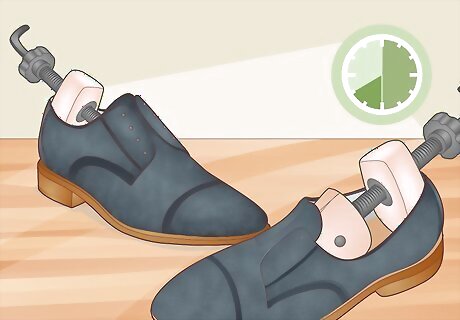
Leave the device in place for 6-8 hours. As it sits, the constant pressure exerted by the stretcher will force the shoe’s upper material to effectively mold itself into a new shape. Once the recommended time is up, remove the stretcher and do it all over again with the other shoe. You could even leave the stretcher in overnight if you really want to get things loosened up.
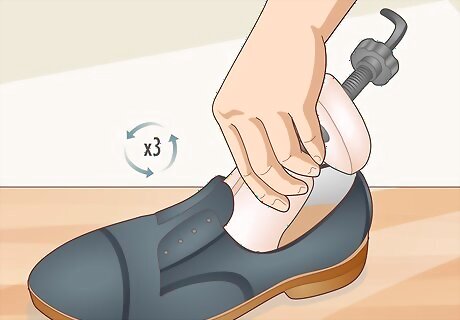
Repeat the process up to 3 times if necessary. In some cases, it may take several rounds of stretching to make a noticeable difference with shoes that are particularly unyielding. Be sure to spray the shoes thoroughly prior to inserting the stretcher. It’s not a good idea to stretch that same shoe more than 4-5 times total during its lifespan. Excessive stretching could weaken certain materials, increasing the likelihood of fraying, holes, or rips. If your shoes are still uncomfortably snug after a few attempts, you may have no choice but to shop for a new pair in a bigger size.
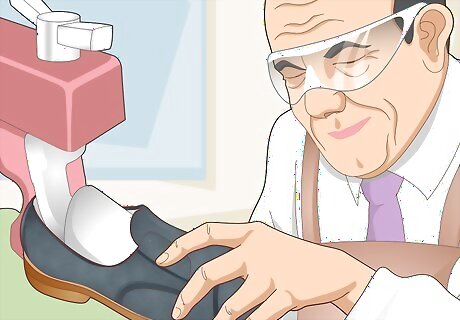
Consider having your shoes stretched by a professional. An experienced shoe repair specialist will have the skills and know-how needed to modify your footwear’s fit without risking unnecessary wear or damage. They’ll also be able to address other comfort issues specific to your anatomy, like bunions, corns, and blisters. Most shoe repair experts charge somewhere between $15 and $25 for basic services like stretching, which is about what you would pay for a shoe stretcher of your own. It’s strongly advised that you take your shoes somewhere rather than attempting to stretch them yourself if they cost you a pretty penny.
Applying Heat with a Hair Dryer
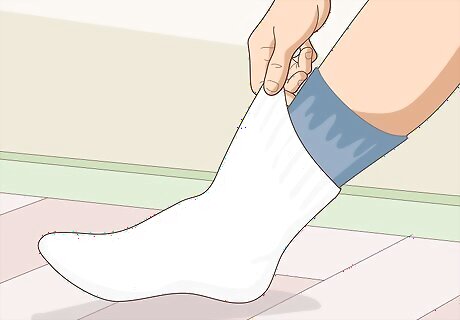
Pull on one or more pairs of thick socks. To make this method as effective as possible, layer up as many pairs as you can while still being able to get your feet all the way in your shoes. The idea here is simply to create some extra bulk that will press out on the material from the inside. Winter, hiking, and knitted socks are generally thicker than ordinary casual-wear varieties.
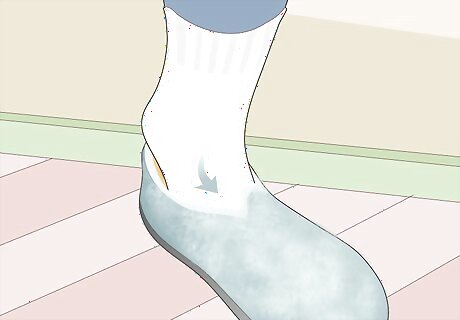
Stuff your feet into your shoes. Now comes the hard part. If you thought it was a tight fit in there before, just wait until your feet are bundled up like cozy little mummies. It might be uncomfortable, but that just means it’s working. If you find that you can’t wedge your feet in all the way, take off one pair of socks and try again. You may have to do this several times in order to get them to fit. If your shoes have laces, tie them securely to keep them from shooting off and breaking a window.
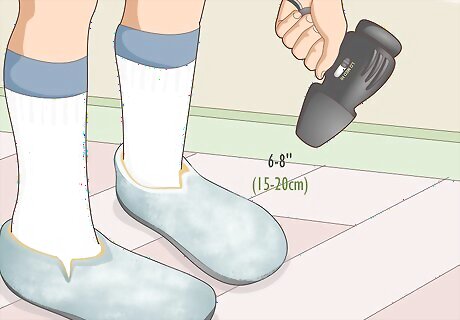
Hold the nozzle of a hair dryer 6–8 inches (15–20 cm) away from your shoes. Be sure to maintain this distance at all times. Exposing your shoes to prolonged, direct heat could result in wrinkling, cracking, singeing, melting, and other temperature-related damage. Wrinkling and cracking are especially likely to be an issue if your shoes are fashioned from artificial leather, vinyl, or another synthetic material.
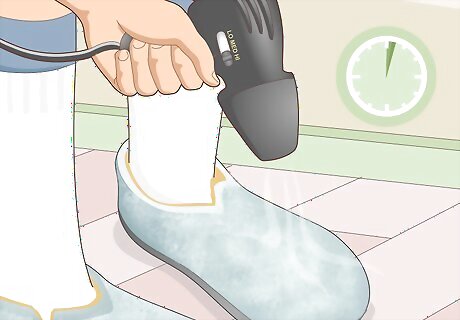
Set the hair dryer to high heat and wave it over your shoes for 1-2 minutes. Focus the stream on the toe, heel, and the length of the instep—in other words, all the areas that are fighting back against your feet. Ideally, you’ll be able to feel the shoes squeezing your feet less and less as you work. Avoid heating your shoes for more than 2 minutes at a time. This is almost guaranteed to cause serious, irreversible damage, no matter what they’re made of. When you warm up the material sufficiently, it will begin to relax. This, combined with the bulging pressure of the socks, will stretch the stubborn material to its limit.
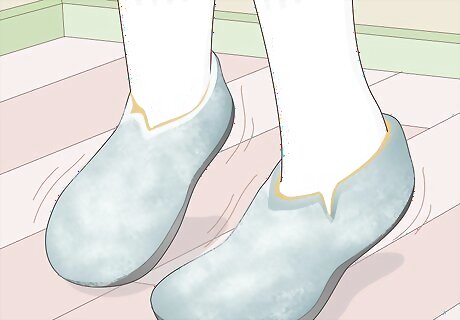
Move your feet around as much as possible. Spread your toes, raise up on the balls of your feet, or rock back and forth. You could even jog in place, throw a high kick or two, or do some easy yoga poses. The more you bend, flex, curl, and knead, the better your heat treatment is likely to work. Your movement may be quite limited for obvious reasons, so just do the best you can. This technique will make your shoes more roomy in terms of both length and width, thanks to all the multi-directional wiggling.Tip: One move that may be particularly helpful is to root your soles firmly to the floor, then try to forcefully slide your feet forward and backward as though you were wiping your feet, only without actually picking them up. This will apply more direct strain to the toe and heel walls.
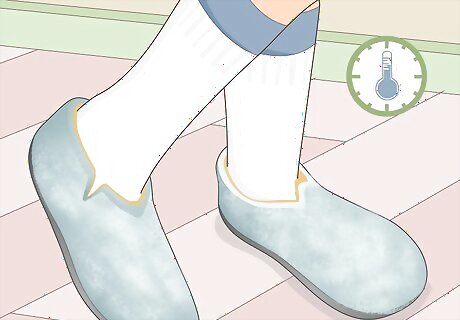
Wear your shoes until they cool off. This shouldn’t take more than 5-10 minutes, tops. However, it’s a good idea to leave them for a few extra minutes just to keep them from shrinking as they return to their normal temperature. Afterwards, you can kick them off and put an end to your agony. With any luck, they’ll be a tad more form-fitting the next time you put them on. It may help to run through these steps more than once, especially if your shoes are brand new. Keep in mind, however, that although there’s no strict limit to the number of times you can break out the hair dryer, all that heat and movement will add to your shoes’ cumulative wear and tear. If your feet feel just as cramped when it’s all said and done, accept your defeat with dignity and consider putting your ill-fitting footwear up for consignment.
















Comments
0 comment